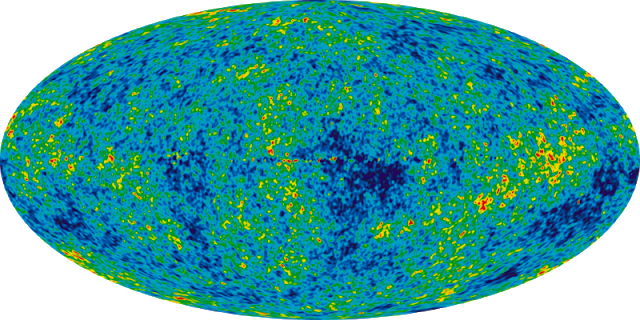Australian Student Uncovers the Universe’s Missing Mass

I. Original Article, as presented by UniverseToday:
“Not since the work of Fritz Zwicky has the astronomy world been so excited about the missing mass of the Universe. His evidence came from the orbital velocities of galaxies in clusters, rotational speeds, and gravitational lensing of background objects. Now there’s even more evidence that Zwicky was right as Australian student – Amelia Fraser-McKelvie – made another breakthrough in the world of astrophysics.
Cosmic Microwave Background Courtesy of NASA / WMAP Science Team
Working with a team at the Monash School of Physics, the 22-year-old undergraduate Aerospace Engineering/Science student conducted a targeted X-ray search for the hidden matter and within just three months made a very exciting discovery. Astrophysicists predicted the mass would be low in density, but high in temperature – approximately one million degrees Celsius. According to theory, the matter should have been observable at X-ray wavelengths and Amelia Fraser-McKelvie’s discovery has proved the prediction to be correct. Dr Kevin Pimbblet from the School of Astrophysics explains: “It was thought from a theoretical viewpoint that there should be about double the amount of matter in the local Universe compared to what was observed. It was predicted that the majority of this missing mass should be located in large-scale cosmic structures called filaments – a bit like thick shoelaces.”
Up until this point in time, theories were based solely on numerical models, so Fraser-McKelvie’s observations represent a true break-through in determining just how much of this mass is caught in filamentary structure. “Most of the baryons in the Universe are thought to be contained within filaments of galaxies, but as yet, no single study has published the observed properties of a large sample of known filaments to determine typical physical characteristics such as temperature and electron density.” says Amelia. “We examine if a filament’s membership to a supercluster leads to an enhanced electron density as reported by Kull & Bohringer (1999). We suggest it remains unclear if supercluster membership causes such an enhancement.”
Still a year away from undertaking her Honors year (which she will complete under the supervision of Dr Pimbblet), Ms Fraser-McKelvie is being hailed as one of Australia’s most exciting young students… and we can see why!”
II. Analysis & Additions by Xploder, AboveTopSecret:
It might be true that energy = mass and mass equals energy and the missing mass in the universe may be in the form of filamentery energy collecting matter into “walls”
Not since the work of Fritz Zwicky has the astronomy world been so excited about the missing mass of the Universe. His evidence came from the orbital velocities of galaxies in clusters, rotational speeds, and gravitational lensing of background objects. Now there’s even more evidence that Zwicky was right as Australian student – Amelia Fraser-McKelvie – made another breakthrough in the world of astrophysics.
What is a filiment? Filiments are the mass of the universe clumping together creating a pathway for energy to transverse. Working with a team at the Monash School of Physics, the 22-year-old undergraduate Aerospace Engineering/Science student conducted a targeted X-ray search for the hidden matter and within just three months made a very exciting discovery. Astrophysicists predicted the mass would be low in density, but high in temperature – approximately one million degrees Celsius. According to theory, the matter should have been observable at X-ray wavelengths and Amelia Fraser-McKelvie’s discovery has proved the prediction to be correct.
Dr Kevin Pimbblet from the School of Astrophysics explains: “It was thought from a theoretical viewpoint that there should be about double the amount of matter in the local Universe compared to what was observed. It was predicted that the majority of this missing mass should be located in large-scale cosmic structures called filaments – a bit like thick shoelaces.” It seems as thought the matter was there all along, it was just low in density and very high in temperature.
So the great structures or “walls” like the great sloan wall and others could account for the missing mass, “These in scale are the filaments and voids. The largest of these filaments is known as the Sloan Great Wall. This giant string of galaxies is 1.4 billion light years across making it the largest known structure in the universe. Yet surprisingly, the Great Wall has never been studied in detail. Superclusters within it have been examined, but the wall as a whole has only come into consideration in a new paper from a team led by astronomers at Tartu Observatory in Estonia.” (UniverseToday).
There are other recent filment walls found and also great “voids” were matter and energy seem to be missing.
“In 2004 astronomers found an enormous hole in the southern hemisphere of the Universe, nearly a billion light-years across, empty of both normal matter such as stars, galaxies, and gas, and the mysterious, unseen “dark matter.” This was a startling finding, since accepted models of the early universe say that the big bang created an initially uniform cosmic landscape, when viewed on large scales. While earlier studies have shown holes, or voids, in the large-scale structure of the Universe, this discovery dwarfed them all. This “nothing” is an enormous hole in the cosmos that defies standard cosmology and might just be the imprint of another universe bumping against our own while some astronomers suggested the spot could be a supervoid, a remnant of an early phase transition in the universe.” (DailyGalaxy).
“Up until this point in time, theories were based solely on numerical models, so Fraser-McKelvie’s observations represent a true break-through in determining just how much of this mass is caught in filamentary structure. “Most of the baryons in the Universe are thought to be contained within filaments of galaxies, but as yet, no single study has published the observed properties of a large sample of known filaments to determine typical physical characteristics such as temperature and electron density.” So it sounds like when you take into account the amount of material in these filiments and the temperature and distrabution or density the picture of where the missing matter sudenly makes sence, the missing mass is acually there in great structures called “walls” and these can be seen in xray images and when the amount of matter is calculated using the xray data not much mass is missing.
“A team of the British, American, and Hungarian astronomers have reported even larger structures. As per their findings, the universe is crossed by at least 13 ‘Great Walls’, apparent rivers of galaxies 100Mpc long in the surveyed domain of 7 billion light years. They found galaxies clustered into bands spaced about 600 millon light years apart. The pattern of these clusters stretches across about one-fourth of the diameter of the universe, or about seven billion light years. This huge shell and void pattern would have required nearly 150 billion years to form, based on their speed of movement, if produced by the standard Big Bang cosmology.” – by Ashwini Kumar Lal, Ph.D. It should have taken upto 80 billion years for these structures to form and some of the missing mass is in the form of electron density and some mass is in the form of matter. When I think about how much electron density it would take and how much matter we can see in these walls, it makes me think: if Energy = Mass and Mass = Energy and where you find large clumps of energy you find large chunks of mass or large walls of mass, maybe the electron density is what is creating the ideal conditions to attract Mass.
– If the electron flow is high enought could the flow of electron density attract matter and cause the galaxies to form the super cluster filiments we see today? – Could electrical charge attract mass? – Could the opposite electrical charge repell mass? – Does this electron density create mass?
“Discovery of the Great Walls of galaxies and filamentary clumping of galactic mater has greatly upset the traditional notion that galactic matter should be uniformly distributed. If the universe began with a Big Bang 13.7 billion years ago, the awesome size of these large-scale structures is baffling because there is apparently not sufficient time available for such massive objects to form and to become organized.
Based on the cosmological principle, which is one of the cornerstones of the Big Bang model, cosmologists predicted the distribution of matter to be homogeneous throughout the universe, implying thereby that the distribution of the galaxies would be essentially uniform. There would be no large scale clusters of galaxies or great voids in space. Instead, contrary to the “Big Bang” universe, we exist in a very “lumpy” cosmos.” When we look closer to these “clusters” or “super clusters” that group together to form these walls, we must ask: are the walls able to form in the time allowed under the current theories (like the big bang theory)? After all, the unverse is only 14 billion years old according to the BBT. But some of these structures are thought to have taken up to 100 billion years to form. Do we need to adjust the big bang or replace it? Do galaxies form a thousand times faster than we think? There is a clear contradiction between how long it should take to form the galaxys and for them to form into clusters then super clusters and then into the great walls.
If the Dark Matter problem is now solved by electron density, could the same mecanism be responcable for Dark energy? Dark energy is the force that “appears” to drive the galaxy apart but looking at these walls, they do not seem to suffer from flying apart; instead they seem to be clumping together & this makes a lot of the dark energy problem look like electron density attraction and repulsion could account for the attraction into clusters and the ejection of others from the cluster arrangements. This was the accepted ratio of matter in the universe. I wonder what the results of this will be will we find that electron density and matter will account for all or just some of the missing matter in the universe?
First results from a major astronomical survey using a cutting-edge technique appear to have confirmed the existence of mysterious dark energy. Dark energy makes up some 74% of the Universe and its existence would explain why the Universe appears to be expanding at an accelerating rate.
The finding was based on studies of more than 200,000 galaxies. Scientists used two separate kinds of observation to provide an independent check on previous dark energy results.
The second type of observation involves measuring how quickly clusters of galaxies have formed over time. Both of these techniques confirmed the existence of dark energy and the acceleration in the expansion of the Universe.
The concept of dark energy was first invoked in the late 1990s by studying the brightness of distant supernovas – exploding stars. “The professor of astrophysics at Portsmouth University, UK, added: “It’s re-confirmation of dark energy, it gives us another data point to fit our theories around and it shows us the way to the future. More astronomers are going to be doing this in years to come.”
While dark energy makes up about 74% of the Universe, dark matter – which does not reflect or emit detectable light – accounts for 22%. Ordinary matter – gas, stars, planets and galaxies – makes up just 4% of the cosmos.
However, despite scientists being able to infer the existence of dark energy and dark matter, these phenomena still elude a full explanation. (…) approximately one million degrees Celsius.”
What does 1 million degrees celsius do to electron density, and what is the ratio of electrical charge if the matter and electrons are super hot but very thinly spread?
I’ve recently read that there is a prefered orintation to some galaxys in cluster formations and they seem to be in a round shape with there discs in a vertical position and it could be that as the filimentary energy transvserse the luster the energy aligns the individual galaixes. There could be enough electron density to set up a rotation of these groups of galaxies around the path of the flow of energy through the filiment, and there is a chance that the energy is the cause of the grouping of the clusters and super clusters. This energy flow may account for the voids by giving a “path” for the energy to flow through attracting more mass to the energy flow like a ping pong ball on a string under running water. As the energy flows it creates a “current” of movement that “draws” matter into these filiments that then allows more matter to “clump together” into the filiments. In electricity terms this is called “a path of least resistence” and as the energy flows in a direction where there is more points in the path to “connect the flow” more matter is drawn to the flow reinforcing the flow increasing the amount of matter, and this reduces the resistence to flow and allows these great walls to form.
In the big bang cosmology the universe should be “homoginous”, which means the great walls and voids should not be there, but they are! The matter should be flying appart from each other, as in the expansion of the universe predicts. Instead we find over billions of years the matter is clumping together into filiments which counters both the expansion and the big bang theories. How can the matter of the universe be speeding away from all the other matter yet form these walls? This is really an astonishing discovery!



 Creators of mankind
Creators of mankind Description of “Tall white aliens”
Description of “Tall white aliens” Where they came from?
Where they came from? About hostile civilizations
About hostile civilizations The war for the Earth
The war for the Earth “Tall white aliens” about eternal life
“Tall white aliens” about eternal life Video: “Nordic aliens”
Video: “Nordic aliens” Aliens
Aliens Alien encounters
Alien encounters The aliens base
The aliens base UFO
UFO Technology UFO
Technology UFO Underground civilization
Underground civilization Ancient alien artifacts
Ancient alien artifacts Military and UFO
Military and UFO Mysteries and hypotheses
Mysteries and hypotheses Scientific facts
Scientific facts


















